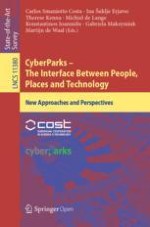1 Introduction
2 Theoretical Framework
2.1 The Intelligent City Concept
2.2 The Cyborg-Society and the Senseable City Concept
-
Tracking as the top-down method where the information is gathered and visualized for decision-makers, stakeholder, city council or researcher (Ratti et al. 2007).
-
Interaction as the bottom-up example with, e.g. QR codes (Foth et al. 2015). The interaction includes human to human, human to companies (marketing) or authorities (information) or human to machine while the layer that carries the QR code is differently (i.e. cloths, streets, buildings, etc.)
3 Interaction Design and Interfaces
3.1 Basic Concepts of Interaction
-
Temporality – It refers to the concept of time. In design it can concern, for example, the extension over time, the duration of an interaction, the immediacy of the interaction activity, the delays and pauses within an interaction, the segmentations of an interaction, the separation and connection of several interaction sequences, the pace and rhythm of an interaction, and the periodicity (Buxton 2010; Löwgren and Stolterman 2004).
-
Interactivity – The interactivity generally refers to how users and (digital and physical) artefacts initiate and respond to different actions including action openings, turn-taking by humans but also by tasks of a device, and closures (Löwgren and Stolterman 2004).
-
Sequentiality – One very important aspect of designing for interaction refers to how interactions are ordered and structured; the flow of different actions and tasks to be accomplished, how courses of events are planned and how much freedom, control, guidance, support etc. are built into activities with the service, components or system (Benyon 2014; Löwgren 2002).
3.2 Types of Interfaces
-
Voice User Interface (VUI) - In this first kind of interface, the human voice is the vehicle through which the information is carried from the user to the software. Various challenges are currently being addressed in the developing of such interfaces, all more or less related to the voice recognition issue, that allows a more functional voice-controlled interface. In turn, the interaction re-quired with this kind of interface is quite natural since it doesn’t require any-thing else than the vocal command of the user.
-
Tangible User Interface (TUI) - As the name suggests, this kind of interface is based on a physical medium that stands between the user and the software. The latter can be a door, a spoon, or in general an available object in an urban space. Although the TUIs are relatively new, numerous examples can be found in museums, architecture (Wang et al. 2017a), furniture and clothing, and this remarks the importance of such a kind of interface. An interesting aspect regards the experience that the user gets from the just introduced interface: the more playful and active way of interacting facilitates a more creative and learning effect (Wang et al. 2017b).
-
Natural User Interface (NUI) - While a TUI exploits tangible objects to create a way of communication between the software and the user, a NUI reaches the same result making use of gesture (Li et al. 2016) and eye-interaction. This results in a more natural way of interacting.
-
Brain Computer Interface (BCI) - Finding its place in the borderline of the scientific progress, the BCI is probably the most interesting and appealing kind of interface that can be found today. The interaction between the user and the software is here carried out by the mean of electric impulses running through the brain and collected by the mean of electrodes. The BCI will make possible to control robotic arms, machines etc. in a large variety of application areas (medical, industrial, etc.). Such kind of innovation will, in addition, help many people with disabilities in improving their life in a huge number of situations.
-
Cross-Object User Interfaces (COUI) - Cross-objects user interfaces is a literally new term that describes user interfaces spatially distributed across object surfaces in the physical world and the virtual reality in a similar way. In contrast to tangible user interfaces, COUIs are inhabited in physical or virtual objects in flexible ways and are compatible with multiple and different interaction methods (Sun et al. 2018; Li et al. 2017).
4 The Ternary Structure of a POS and Its Scientific Rationalities Interpretation
-
Nature is the environment in its essential form, i.e. without any human interference.
-
Culture is any expression of human’s creativity, that can be differentiated into tangible (materials and artefacts) and intangible (values, traditions, beliefs, etc.).
-
Geist is the source of human’s creativity itself; it defines human’s goals, objectives and lines of action that modify the nature towards the realization of what we defined culture (Fig. 2).Fig. 2.The public spaces ternary structure: Geist, Culture and Nature(Source: authors)×
